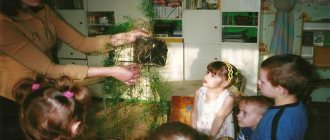The importance of environmental education for preschool children
Svetlana Evseeva
The importance of environmental education for preschool children
THE IMPORTANCE OF ECOLOGICAL EDUCATION FOR PRESCHOOL CHILDREN.
The formation of the initial foundations of ecological culture is the accumulation of specific, sensory ideas about objects and natural phenomena that surround children and are part of their life activities. An important aspect of environmental education is the formation of children’s understanding of the specifics of a living object, its fundamental difference from an object (inanimate object), the formation of elementary skills of proper interaction with plants and animals, participation in activities to create the necessary conditions. Raising children will not become ecological if already at this age they will not understand: the plant on the window needs water, the parrot in the cage needs grains and water, the birch tree and flowers on the site need water, and the birds in winter need feeders and bread crumbs. Familiarization with natural objects, their parts, basic properties, visual ways of functioning in under completely certain conditions - this is the formation of initial ecological ideas ... The correct attitude towards living things is the end result, an indicator of environmental education , manifested at this age only in the voluntary and active participation of children in joint activities with adults.
Environmental education of preschool children involves the development of a humane attitude towards nature (moral education , the formation of a system of environmental knowledge and ideas (intellectual development, the development of aesthetic feelings (the ability to see and feel the beauty of nature, the participation of children in activities feasible for them to care for plants, to protect and protection of nature.
When forming a humane attitude towards nature, it is necessary to proceed from the following: the main thing is that the child understands that man and nature are interconnected. Feelings of compassion and empathy determine an effective attitude towards nature, expressed in a willingness to take care of those who need it. It must be remembered that children’s often careless and sometimes cruel attitude towards nature is explained by their lack of the necessary knowledge. That is why the education of empathy and compassion occurs in inextricable unity with the formation of a system of environmental knowledge accessible to preschoolers , which includes:
Ideas about plants and animals, their needs and ways to satisfy these needs; understanding the relationship between living beings and their environment, realizing that all living beings on Earth are connected to each other by a complex system of relationships (biological balance)
and at the same time, each of them has its own
ecological niche , and all of them can exist simultaneously.
Together with parents and children, we created an environmental book (based on the poem I gave about wildlife, attitude towards animals, rules of behavior in nature, they drew a picture) I bring to your attention the cover of the book!
MAGAZINE Preschooler.RF
Main directions of environmental education of preschool children.At the main stage of social development, the issue of environmental education becomes particularly acute. In this regard, it is necessary to pay more attention to the environmental education of children from the first years of life, since it is during this period that the child develops his first worldview - he receives emotional impressions about nature and society, accumulates ideas about different forms of life, the basis of environmental thinking is formed, consciousness and culture.
During this period, the foundations for interaction with nature are laid; with the help of adults, the child begins to recognize it as a common value for all people. Wildlife has long been recognized in pedagogy as one of the most important factors in the education and upbringing of preschool children.
Communicating with it, studying its objects and phenomena, preschool children gradually comprehend the world in which they live: they discover the amazing diversity of flora and fauna, realize the role of nature in human life, the value of its knowledge, experience moral and aesthetic feelings and experiences that motivate them take care of the preservation and enhancement of natural resources.
The severity of modern environmental problems has confronted pedagogical theory and practice with the task of educating the younger generation in the spirit of a careful, responsible attitude towards nature, capable of solving issues of rational environmental management, protection and renewal of natural resources. In order for these requirements to become the norm of behavior for every person, it is necessary to purposefully cultivate a sense of responsibility for the state of the environment from childhood.
The goal of our work is to form ideas in preschool children about the flora and fauna of the natural world of their native land in connection with their habitat, environmental behavior in nature and respect for it.
To achieve this goal, the main tasks were identified:
- deepen and expand environmental knowledge
- instill basic environmental skills and abilities - behavioral, cognitive
- develop cognitive, creative, social activity of preschool children during environmental activities
- to form (nurture) feelings of respect for nature.
All work on environmental education was carried out in two directions: in direct educational activities and in everyday life. The knowledge, skills and abilities acquired by the children were consolidated every day in kindergarten and at home.
From the age of 3-4, children’s attention was drawn to some of the most striking noticeable phenomena and events characteristic of different times of the year. We gave the children information little by little, using games and fun. To consolidate, the same objects and phenomena were repeated several times.
In the second younger group, the children were involved in active participation in caring for indoor plants: watering, wiping the leaves. Each child gradually became familiar with material on caring for plants so as not to harm them. With the onset of winter, we fed the birds on the site. We made feeders together with our parents and placed them close to the window so that the children could watch the birds every day.
In older preschool age, they were involved in subject-transforming activities in nature. They were taught to intelligently use nature, work, conserve natural resources, and acquire practical experience in relation to the natural environment. As a result, the children developed practical knowledge, personal experience of influencing the environment and saving wealth, enriching cognitive interests, and the need for activity in the natural environment.
Based on the leading didactic principles and analysis of the interests and inclinations of preschoolers, various forms of environmental education were used
- mass;
- group;
- individual.
Mass forms included environmental festivals, role-playing games, and work on the site.
Group forms included excursions, hiking trips to study nature, and environmental workshops.
Individual forms of observing animals and plants, making crafts, drawing, modeling.
For each observation, a small amount of information was selected. Ideas about objects and natural phenomena were formed in preschoolers gradually, in the process of repeated “meetings” with them. In each subsequent observation, they recalled, clarified, consolidated and specified, and expanded the received ideas. In organizing observations, they thought through the system and their interrelationship, which ensured that children understood the processes and phenomena that they observed. Observation stimulated the children's interest and their cognitive activity.
Along with observations, visual illustrative material was widely used, which helped to consolidate and clarify children’s ideas obtained during direct observations. With their help, preschoolers formed ideas about objects and natural phenomena that are currently impossible to observe, children became familiar with ongoing phenomena in nature (seasonal changes), and information of natural history content and nature was generalized and systematized.
Play played a major role in introducing preschoolers to nature. Plot-role-playing games assumed the presence of natural history, environmental and environmental content and the existence of certain knowledge: “Trip to an exhibition” , “Expedition to Africa” , “Journey to the sea” .
We selected a variety of didactic games with environmental content: “Wild - domestic” , “Poisonous and safe plant” , “Where, whose house?” , “What is harmful and beneficial for nature (water)?” , “Dangerous - not dangerous” , “Choose edible mushrooms, berries” , “Let's pack a backpack for the road” , etc.
Used object games using natural materials (pine cones, pebbles, shells, etc.) contributed to the development of the child’s thinking. For example, objects can be classified according to different characteristics (color, size, shape). It is important that children also participate in collecting natural materials.
They played intellectual games - “KVN” , “What? Where? When?" , “Brain - Ring” , the children were delighted not only with the game, but also with the preparation for the game itself.
Particular attention requires the creation of conditions for independent environmental play, research activities and modeling. In a corner of nature, we created a collection of natural waste materials for making crafts.
The most important form of working with children is work in nature. This type of activity, like no other, contributed to the formation in preschoolers of an awareness of the correct attitude towards nature. In the process of working, the children had the opportunity to put their knowledge into practice, acquire new ones, and clearly see the existence of various relationships in nature (plants, animals and the environment). They developed the necessary care skills and a sense of responsibility for a living organism.
Positive emotions were evoked in children during drawing classes, applique work, modeling and design, performing performances on natural history themes, reading fiction - all this contributed to the formation of a consciously correct attitude towards nature in preschoolers and attracted them to environmental activities.
Environmental education of preschool children can be considered as a process aimed at developing an environmental culture for all family members. Environmental education (enlightenment) of parents is one of the extremely important and at the same time one of the most difficult areas of work of a preschool institution. One of the primary tasks is to involve adult family members (even grandparents to a greater extent than busy dads and moms) in working together. The preschool age of a child is a period when many of them themselves strive for contact and cooperation with teachers, which is very important for environmental education. The family as an environment for personality formation has a huge influence on the formation of the child’s foundations of an ecological worldview. The foundation of moral education is also laid in the family and specifically during early childhood.
Adults received environmental information:
- at parent meetings
- during a visit to the kindergarten territory
- from consultations for parents
- in joint activities with children.
In addition to traditional forms of work and preschool education and family, we actively use innovative forms and methods of work:
- Round table “Ways to implement the system of environmental education in kindergarten” ;
- Thematic exhibitions: photo exhibition “Pets” , exhibition of drawings “Don’t be late, save the planet!” ;
- Family meetings with an environmental focus: “Together along our ecological path” , “Plant a tree” ;
- Family talent competition: “Miracle - Vegetables” , “Save the Christmas Tree” , “Bird’s Canteen” .
Working with parents should be a gradual and ongoing process, and the environmental information we offer to parents is personally meaningful to them. The joint activity of an adult and a child contributed to cooperation, emotional and psychological rapprochement between the child and the adult.
Thus, based on all of the above, we can conclude that when organizing work with preschool children, it is necessary to focus on the age-related, individual and differentiated characteristics of children. It is also necessary to properly organize interaction with the family so that the work on environmental education continues at home.
Literature
- Kulikovskaya, I. E. Children's experimentation [Text] / I. E. Kulikovskaya, N. N. Sovgir. – M.: Publishing House of the Pedagogical Society of Russia, 2011. _ P.79.
- Makhaneva, M. D. Ecology in kindergarten and primary school. Methodological manual [Text] / M. D. Makhaneva. - M.: TC Sfera, 2010. - P. 171.
- Nikolaeva, S. N. Methods of environmental education of preschool children [Text] / S. N. Nikolaeva. – M., 2009. – P. 57.
| Next > |
Principles for selecting the content of environmental education for preschool children
⇐ PreviousPage 6 of 24Next ⇒
The content of environmental education for preschoolers should be considered, first of all, within the framework of the system of continuous environmental education. Thus, the principles of content selection developed for other levels of education must be adapted, specified and supplemented for the preschool level. Only in this case will the basic principle of the system of continuous environmental education—continuity—be observed. In preschool age, knowledge plays a much smaller role than at subsequent levels of education. In addition, they must be accessible and attractive to children.
The principles for selecting the content of environmental education for preschoolers can be divided into three groups: general didactic, specific for environmental education in general, and specific for the preschool level.
Scientificity. For the first time in preschool pedagogy, the principle of science was formulated by A.P. Usova, who Fr. From the point of view of environmental education, the principle of science presupposes the acquaintance of preschool children with a set of elementary environmental knowledge, which serves as the basis for the formation of motivation for a child’s actions, the development of cognitive interest, and the formation of the foundations of an ecological worldview.
Availability. This principle is closely related to the principle of science. You cannot introduce children to information that is abstract and difficult for them to understand. This approach is negatively perceived not only by children, but also by educators themselves, who do not have enough knowledge. In addition, accessibility also presupposes the significance of the acquired knowledge for the child and its emotional connotation.
Humanity. This principle is associated, first of all, with the concept of ecological culture. From the perspective of education, the application of this principle means raising a person with new values, who knows the basics of consumer culture, who cares about his health and wants to lead a healthy lifestyle. Ultimately, the goal of environmental education is to preserve human health in a healthy, environmentally friendly environment. The principle of humanism is also realized through the cultivation of a consumer culture. The content of environmental education should also contribute to the child’s formation of ideas about man as a part of nature and the intrinsic value of nature, to cultivate a respectful attitude towards all forms of life on the planet, and reverence for all manifestations of life. The principle of humanism involves instilling in a child ideas about the diversity of nature’s values: aesthetic, moral, cognitive, practical, etc.
Predictiveness. In relation to preschool age, this principle means that as a result of environmental education, children form elementary ideas about the relationships that exist in nature and, on the basis of these ideas, the ability to predict their actions in relation to the environment during rest, work in nature and everyday conditions. Compared to school, in preschool education, due to the age characteristics of the child, prognostication is limited to instilling in children the habit and ability to evaluate their everyday actions in relation to the environment, and to restrain their desires if their implementation may harm the environment.
Activity. The child’s environmental knowledge becomes the basis for the formation of motivation for his participation in various feasible activities to preserve the environment. On the one hand, such activity is a unique result of the child’s motivation and needs formed in the process of environmental education, a criterion for the level of environmental culture; on the other hand, in the process of the activity itself, the formation and formation of the “child - environment” relationship occurs. Ryzhova. So, G.A. Yagodin O.
The principle of activity in the relationship “child - nature” in preschool pedagogy is traditionally implemented in the process of a child caring for indoor plants, animals, and working in the garden. However, from the perspective of environmental education, it is necessary to expand the scope of such activities through the participation of children together with adults (especially parents) or older children in various environmental activities, assessing the condition of their home, yard, kindergarten territory, group (for example, what plants grow around us, whether there are enough of them, how water is used at home, etc.). This approach makes it possible to make the child’s activities more meaningful and necessary for him personally.
Integration. The importance of taking this principle into account in preschool environmental education is due to several reasons: firstly, the integrated nature of environmental knowledge as such; secondly, consideration of environmental education from the point of view of the comprehensive development of the child’s personality and, thirdly, the peculiarities of the organization and methodology of all work in a preschool institution.
In addition, a preschooler is characterized by a holistic perception of the world around him. Ecology as a science is characterized by a high level of integration: philosophy, science, art, practical activity. At the preschool level, this is reflected in the need to green the entire activity of the teaching staff and green the various types of activities of the child.
Integrity. This principle is closely related to the previous one. It is inherent specifically in preschool environmental education and reflects, first of all, the child’s holistic perception of the world around him, his unity with the natural world. The process of working with children in a preschool institution should also be built taking into account a holistic approach.
Constructivism. This principle means that only neutral, positive or negative-positive information should be used as examples for preschoolers. The latter assumes that, by citing negative facts about human influence on nature, the teacher is obliged to show the child a positive example or a probable way out of this situation. It is extremely important to emphasize what exactly the child himself, his family, and kindergarten can do, and give examples of successfully solved environmental problems, preferably using examples from the immediate environment.
Regionalism. Environmental education of preschool children should be based, first of all, on the objects of the immediate environment, which is associated with the specific thinking of children of this age. Teachers and parents themselves should be familiar with global problems. The formation of environmental ideas (including about various environmental problems), environmentally literate behavior, and an appropriate attitude towards the environment occurs on the basis of familiarity with the objects of the immediate environment: the premises of a preschool institution and its territory, one’s own apartment. dachas, the nearest park, square, forest, lake, aquarium, indoor plants and animals. For the purposes of environmental education, objects and phenomena must be selected that are accessible to the child, the essence of which he can learn in the process of children's activities.
In the process of environmental education, it is important to show the child the features of the relationship between man and nature using examples from the region.
Systematicity . Material that is ordered in a certain way into a clear, integral system with a simple principle of construction is easier to assimilate than scattered, random material. In this regard, the question arises about the principles of selection and systematization of environmental knowledge. At the same time, the sequence of knowledge acquisition is important, when “each subsequent emerging idea or concept follows from the previous one, and the entire system is based on certain initial positions that act as its central core.” These provisions of the concept of preschool childhood pedagogy, developed under the leadership of A.V. Zaporozhets, are also relevant for environmental education
The principle of consistency is of particular importance in teaching preschoolers, since its application contributes to their mental development as a whole.
As in preschool pedagogy in general, in environmental education the principles of knowledge systematization ensure the implementation of the scientific principle, since the systematization is based on ideas and elementary concepts that reflect the basic laws of nature and social relationships. In the spontaneous experience of children, there are already scattered ideas about animals, plants, and, to a lesser extent, about inanimate nature. The principle of systematicity also implies consideration of living objects as systems of a certain level (a living organism as a system; a meadow, a forest-ecosystem).
Continuity. The fundamental feature of the environmental education system is the continuity of all its links. As a rule, there are several relatively independent links (levels, stages) of the system of continuous environmental education: kindergarten - school - university - advanced training of specialists. The principle of continuity suggests that preschool education should have a close connection with all levels of the system of continuous environmental education. Thus, it is necessary to maintain continuity in the work of kindergarten and primary schools, preschool institutions and pedagogical colleges, higher educational institutions that train future specialists. From a similar perspective, it is necessary to consider the retraining of preschool education personnel in various advanced training courses. However, two-level connections currently predominate; “kindergarten - primary school”, “kindergarten - pedagogical college”, “kindergarten - teacher training university”. An analysis of numerous environmentally friendly programs for primary schools shows that their authors do not always take into account the capabilities of preschool institutions; there is an underestimation of both the age-related capabilities of a preschool child and the current state of preschool environmental education. Not all schools show interest in cooperation with preschool institutions. The only exceptions are educational complexes that create optimal conditions for the implementation of the principle of continuity. Almost all preschool workers call the problem of continuity between kindergarten and primary school one of the main and unresolved problems of pedagogy.
The problem of continuity in the content of environmental education for preschoolers and primary schools consists of orderliness, selection of the main components of this content, their correspondence to each other, implementation of the principle of consistency at both levels, development of a system for increasing the complexity of knowledge, depending on the age of the child.
Content of environmental education for preschool children in partial programs
Environmental education of preschoolers is a process of formation in children
consciously correct attitude towards natural objects with which they
directly contact. This relationship arises in connection
intellectual, emotional and effective components. Their combination is
the moral position of the child, manifested in various forms of his behavior.
A partial program is a program implemented as part of the main educational activity, which is aimed at implementing one or more areas of child development.
Program “Our home is nature”
Developed by N. A. Ryzhova (Doctor of Pedagogical Sciences).
The main goal of the environmental program “Nature is Our Home” is to educate from the first years of life a humane, socially active, creative personality, capable of understanding and loving the world around us, nature and treating them with care.
The program contains a basic component, which is specified taking into account local conditions: ecological-geographical, national-cultural.
The “Our Home is Nature” program consists of ten blocks. Each includes teaching and educational components - knowledge about nature and the development of various aspects of children’s attitude towards it (caring for it, the ability to see beauty, etc.) Half of the program (five blocks) considers the area of inanimate nature (water, air, soil, etc.) , three blocks are devoted to living nature - plants, animals and the forest ecosystem, two - interaction
man with nature.
“Our Home is Nature” is an original program that ensures continuity in environmental education for preschoolers. Particular attention is paid to the formation of a holistic view of nature and man’s place in it. Children form their first ideas about the relationships that exist in nature and, on this basis, the beginnings of an ecological worldview and culture, a responsible attitude towards the environment and their health.
Great importance is attached to the moral aspect: the development of ideas about the intrinsic value of nature, an emotional positive attitude towards it, the development of the first skills of environmentally literate and safe behavior in nature and everyday life. Children also purchase
initial skills that allow them to participate in feasible practical activities to protect the nature of their native land.
The program is designed to work with children of senior and preparatory school groups (5-7 years old). It is at this age that children acquire the ability to comprehend cause-and-effect relationships and abstract thinking, which is necessary to understand the relationships that exist in nature. The content of the program and the methodology of work take into account the psychological and physiological characteristics of this age. All material is presented in a form that is accessible and attractive to children.
The program has methodological support - development for creating a developmental environment in a preschool institution, recommendations for introducing children to water and air. A valuable aspect of the program is that the author draws attention to waste, which in large part
quantities produced by humanity and which constitute a real danger to the nature of the planet.
The program can be used by preschool institutions of both general developmental, supervision and rehabilitation, and correctional types.
It was developed and tested as part of a scientific experiment on environmental education for preschool children in various types of institutions.
Currently, the program has been successfully implemented and received recognition in a number of regions of Russia.
Program “We are earthlings”
A. Veresov’s program “We are earthlings” aims to develop elements of environmental consciousness in children; it demonstrates the universal
the relationship between nature, man and his activities.
According to the authors, the main goal of the program is to create conditions for the formation of the foundations of environmental awareness among older preschoolers; at the core
consciousness - a value-based attitude to the world, a system of personal meanings.
The “We Earthlings” program is based on a philosophical concept based on the idea: education is the introduction of a growing individual to
culture.
Program objectives:
• providing conditions for the development of semantic positions, the most important of which is the position of an earthling;
• creative self-expression of the child and teacher;
• development of the child's abilities;
• enriching children with knowledge.
The program is based on three approaches: natural science, naturalistic and humanistic (humanitarian).
The essence of the natural science approach is that ecology is considered as a part of biology that studies problems in specific aspects
interaction between the organism and the environment. This approach could be called “survival ecology.” And if the environmental system
education is built on the basis of such an approach, then its goal cannot be anything other than protection from the destructive influences of the environment. Note that
that the natural science approach in the full sense becomes possible only in middle and high school age, when children begin
study biology. The most favorable period for the formation of structures of consciousness (primarily reflexive) is the senior
preschool and primary school age.
The naturalistic approach, in a certain sense, opposes the first, considering the problem from a different angle. It could be
define as “environmental ecology”, because it is based on the study of how the environment dies and is destroyed under the influence of the results
human activity. If environmental education is built on the basis of this very popular and extremely important approach, then its goal will not be able to go beyond the scope of practical ecology (cleanup activities, environmental landings, etc.). Of course, such programs and events are necessary.
⇐ Previous6Next ⇒
Recommended pages:
Use the site search:






